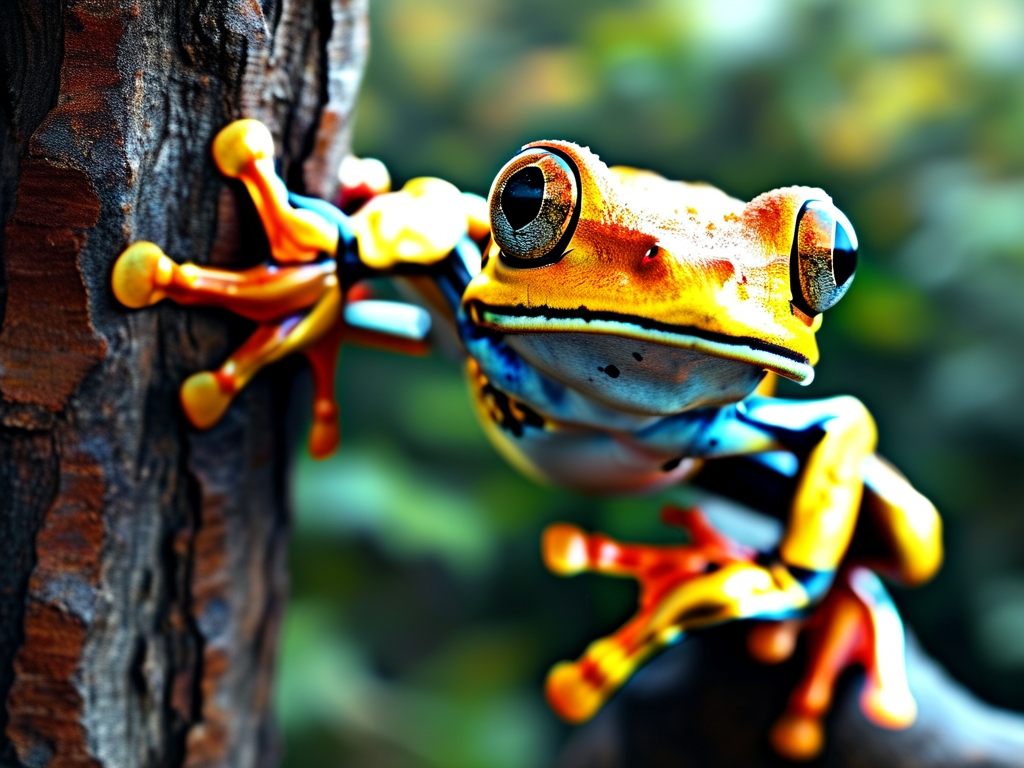In recent years, robotics engineers have turned to nature for inspiration, seeking solutions to complex challenges in mobility, adaptability, and energy efficiency. Among the most fascinating breakthroughs is the development of tree frog-inspired robotics, a technology that mimics the unique biological features of tree frogs to create robots capable of climbing vertical surfaces, navigating uneven terrains, and performing delicate environmental monitoring tasks. This article explores the technical framework behind tree frog robotics, its potential applications, and the innovative engineering principles that make it a transformative advancement in robotics.

The Biological Blueprint: Why Tree Frogs?
Tree frogs (Rhacophoridae) possess extraordinary adaptations that allow them to thrive in diverse ecosystems. Their toe pads, for instance, are covered in microscopic hexagonal structures and mucus secretions, enabling them to adhere to wet or dry surfaces with remarkable precision. Additionally, their lightweight bodies and flexible limb joints grant them agility in climbing and jumping. By reverse-engineering these traits, researchers have developed robots that replicate these functions through a combination of advanced materials, sensor systems, and AI-driven motion algorithms.
Core Components of the Tree Frog Robot Design
-
Adhesive Mechanisms:
The most critical innovation lies in the robot’s adhesion system. Engineers have created synthetic toe pads using soft polymer materials embedded with microfluidic channels. These channels mimic the mucus secretion process, allowing the robot to adjust adhesion strength dynamically. Electrostatic adhesion—a technique inspired by the van der Waals forces in frog toe pads—is also integrated, enabling the robot to cling to glass, metal, and even rough surfaces like tree bark. -
Adaptive Locomotion Algorithms:
Tree frog robots employ machine learning models to optimize movement. Using real-time feedback from pressure and inertial sensors, the robot adjusts its limb coordination to maintain balance on unstable surfaces. For example, when climbing a slippery vertical wall, the AI system calculates optimal weight distribution and limb placement, mirroring the frog’s ability to "feel" its environment. -
Environmental Sensing Suite:
Equipped with multispectral cameras, humidity sensors, and gas detectors, these robots are designed for environmental monitoring. Their ability to access hard-to-reach areas—such as forest canopies or industrial pipelines—makes them ideal for collecting data on air quality, biodiversity, or structural integrity. -
Energy Efficiency:
To replicate the tree frog’s energy-efficient movement, the robots use lightweight actuators and regenerative braking systems. Solar panels integrated into the robot’s surface further extend operational longevity in outdoor environments.
Applications Across Industries
-
Ecosystem Conservation:
Deployed in rainforests or wetlands, tree frog robots can monitor endangered species, track deforestation, and assess pollution levels without disturbing fragile habitats. Their silent movement and low energy consumption make them less intrusive than traditional drones. -
Infrastructure Inspection:
In urban settings, these robots inspect skyscraper exteriors, wind turbines, or underwater pipelines. Their adhesion systems allow them to navigate complex geometries, identifying cracks or corrosion that human inspectors might miss. -
Disaster Response:
After earthquakes or floods, tree frog robots could traverse debris-filled environments to locate survivors or assess structural damage. Their small size and climbing ability enable access to collapsed buildings or unstable terrain. -
Agricultural Automation:
Farmers might use these robots to monitor crop health in vertical farms or orchards. By climbing plants and analyzing leaf moisture or pest activity, they could optimize irrigation and reduce pesticide use.
Challenges and Future Directions
Despite its promise, tree frog robotics faces hurdles. Durability remains a concern—repeated adhesion cycles wear down synthetic toe pads over time. Researchers are experimenting with self-healing polymers to address this. Another challenge is scaling the technology for larger robots without compromising agility.
Future iterations may incorporate swarm intelligence, allowing multiple robots to collaborate on complex tasks. For instance, a swarm could map an entire forest canopy by sharing sensory data in real time. Advances in biodegradable materials might also enable eco-friendly robots that decompose after completing their missions.
Ethical and Environmental Considerations
As with any emerging technology, ethical questions arise. Could invasive monitoring by robots disrupt ecosystems? Engineers emphasize designing robots with minimal ecological footprints, such as noise-free propulsion and non-toxic materials. Additionally, data security protocols must ensure that environmental data collected by robots is used responsibly.
Tree frog-inspired robotics represents a convergence of biology, materials science, and artificial intelligence. By emulating nature’s solutions, this technology opens new frontiers in environmental stewardship, infrastructure maintenance, and disaster response. As research progresses, these agile, adaptive robots may become indispensable tools for addressing global challenges—proving that sometimes, the best innovations are those that have already evolved in the natural world.
With continued investment and interdisciplinary collaboration, the leap from biological curiosity to real-world impact is not just possible—it’s already underway.

